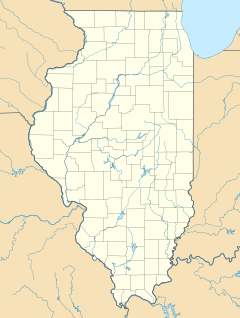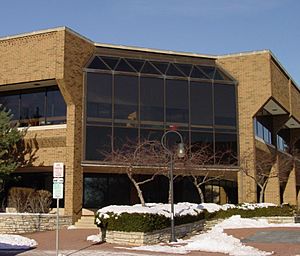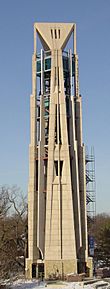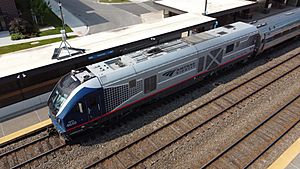Naperville, Illinois facts for kids
Quick facts for kids
Naperville, Illinois
|
||
|---|---|---|
| City of Naperville | ||

Aerial view of downtown Naperville.
|
||
|
||
| Motto(s):
Great Service – All the Time
|
||
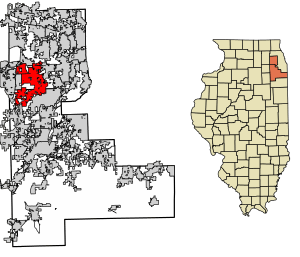
Location of Naperville in Will and DuPage counties in Illinois
|
||
| Country | United States | |
| State | Illinois | |
| Counties | DuPage, Will | |
| Townships | Dupage: Lisle, Milton, Naperville, Winfield, Will: DuPage, Wheatland | |
| Settled | 1831 | |
| Incorporated | February 7, 1857 (Village) March 17, 1890 (City) |
|
| Named for | Joseph Naper | |
| Government | ||
| • Type | Council–manager | |
| Area | ||
| • Total | 39.70 sq mi (102.81 km2) | |
| • Land | 39.11 sq mi (101.29 km2) | |
| • Water | 0.59 sq mi (1.52 km2) | |
| Elevation | 702 ft (214 m) | |
| Population
(2020)
|
||
| • Total | 149,540 | |
| • Density | 3,823.57/sq mi (1,476.29/km2) | |
| Demonym(s) | Napervillian | |
| Time zone | UTC−6 (CST) | |
| • Summer (DST) | UTC−5 (CDT) | |
| ZIP Codes |
60540, 60563–60565, and P.O. box only 60566–60567
|
|
| Area codes | 630 and 331 | |
| FIPS code | 17-51622 | |
| GNIS feature ID | 2395147 | |
Naperville ( nay-PƏR-vil) is a city in DuPage and Will counties in the U.S. state of Illinois. It is a suburb of Chicago, located 28 miles (45 km) west of the city.
Naperville was founded in 1831 by Joseph Naper. The city was established by the banks of the DuPage river, and was originally known as Naper's Settlement. By 1832, over 100 residents lived in Naper's Settlement. In 1839, after DuPage County was split from Cook County, Naperville became the county seat, which would be held until 1868. Beginning in the 1960s, Naperville experienced a significant population increase as a result of Chicago's urban sprawl.
As of the 2020 census, its population was 149,540, making it the fourth most populous city in the state. Naperville's largest employer is Edward Hospital with 4500 employees.
Naperville is home to Moser Tower and Millennium Carillon. It is one of the four largest carillons in the world. Naperville is also home to an extensive parks and forest preserve network, including places such as Centennial Beach. Naperville has two school districts, 203 and 204. Naperville also has media outlets, like NCTV17. Naperville has a train station that is served by Amtrak and Metra.
Contents
History
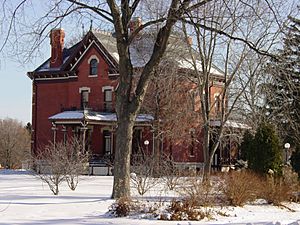
In July 1831, Joseph Naper arrived at the west bank of the DuPage River with his family and friends to found what would be known as Naper's Settlement. Among those original settlers were Naper's wife Almeda Landon, his brother John with wife Betsy Goff, his sister Amy with husband John Murray, and his mother Sarah. Their arrival followed a nearly two-month voyage across three Great Lakes in the Naper brothers' schooner, the Telegraph. Also on the journey were several families who remained in the settlement that would become Chicago, including that of Dexter Graves who is memorialized in Graceland Cemetery by the well-known Lorado Taft statue "Eternal Silence" (also known as "the Dexter Graves Monument").
By 1832, over one hundred settlers had arrived at Naper's Settlement. Following the news of the Indian Creek massacre during the Black Hawk War, these settlers were temporarily displaced to Fort Dearborn for protection from an anticipated attack by the Sauk tribe. Fort Payne was built at Naper's Settlement, the settlers returned and the attack never materialized. The Pre-Emption House was constructed in 1834, as the Settlement became a stage-coach stop on the road from Chicago to Galena. Reconstructions of Fort Payne and the Pre-Emption House stand as part of Naper Settlement outdoor museum village, which was established by the Naperville Heritage Society and the Naperville Park District in 1969 to preserve some of the community's oldest buildings.
In 1855 Sybil Dunbar came to Naperville as its first recorded black female resident; she died in 1868 and was buried in Naperville Cemetery on Washington Street. A commemorative marker honoring her was placed in the cemetery in 2015.
After DuPage County was split from Cook County in 1839, Naper's Settlement became the DuPage county seat, a distinction it held until 1868. Naper's Settlement was incorporated as the Village of Naperville in 1857, at which time it had a population of 2,000. Reincorporation as a city occurred in 1890.
On April 26, 1946, Naperville was the site of one of the worst train disasters in Chicago history. Two Chicago, Burlington and Quincy Railroad trains, the Advance Flyer and the Exposition Flyer, collided 'head to tail' on a single track just west of the Loomis Street grade crossing. The accident killed 45 and injured approximately 127 passengers and/or crew members. This event is commemorated in a metal inlay map of Naperville on the southeast corner of the Nichols Library's sidewalk area. In 2012, author Chuck Spinner published The Tragedy at the Loomis Street Crossing which details the tragedy and gives the stories of the 45 persons who perished. On April 26, 2014, a memorial entitled Tragedy to Triumph was dedicated at the train station. The sculpture by Paul Kuhn is dedicated not only to the crash victims but also to the rescuers at the site.
A predominantly rural community for most of its existence, Naperville experienced a population explosion beginning in the 1960s and continuing into the 1980s and 1990s, following the construction of the East-West Tollway (now known as the Ronald Reagan Memorial Tollway) and Interstate 355 (originally known as the North-South Tollway, now the Veterans Memorial Tollway). It has nearly quadrupled in size as the Chicago metropolitan area's urban sprawl brought corporations, jobs, and wealth to the area.
The March 2006 issue of Chicago magazine cites a mid-1970s decision to make and keep all parking in downtown Naperville free to keep downtown Naperville "alive" in the face of competition with Fox Valley Mall in Aurora and the subsequent sprawl of strip shopping malls. Parking meters were taken down, parking in garages built in the 1980s and 1990s is free, and parking is still available on major thoroughfares during non-peak hours.
Naperville marked the 175th anniversary of its 1831 founding in 2006. The anniversary events included celebrations, concerts and a balloon parade.
Geography and climate
According to the 2010 census, Naperville has an area of 39.323 square miles (101.85 km2), of which 38.77 square miles (100.41 km2) (or 98.59%) is land and 0.553 square miles (1.43 km2) (or 1.41%) is water. Portions of the city of Naperville drain to the West Branch of the DuPage River within DuPage County. Specifically, in the flood of 1996, downtown businesses in the City of Naperville incurred significant damage. Overall, however, Forest Preserve District ownership of a large amount of property along the West Branch has minimized development in flood plains and has helped reduce the damages from overbank flooding that have occurred in the county's more developed watersheds.
Naperville borders the communities of Warrenville, Wheaton, Lisle, Woodridge, Bolingbrook, Plainfield, and Aurora.
| Climate data for Naperville, Illinois | |||||||||||||
|---|---|---|---|---|---|---|---|---|---|---|---|---|---|
| Month | Jan | Feb | Mar | Apr | May | Jun | Jul | Aug | Sep | Oct | Nov | Dec | Year |
| Average high °F (°C) | 30 (−1) |
35 (2) |
47 (8) |
60 (16) |
71 (22) |
80 (27) |
83 (28) |
81 (27) |
75 (24) |
63 (17) |
48 (9) |
34 (1) |
59 (15) |
| Average low °F (°C) | 15 (−9) |
18 (−8) |
27 (−3) |
37 (3) |
46 (8) |
56 (13) |
61 (16) |
60 (16) |
51 (11) |
40 (4) |
30 (−1) |
19 (−7) |
38 (4) |
| Average precipitation inches (mm) | 1.69 (43) |
1.73 (44) |
2.36 (60) |
3.62 (92) |
4.02 (102) |
4.21 (107) |
3.90 (99) |
4.06 (103) |
3.58 (91) |
3.07 (78) |
3.23 (82) |
2.20 (56) |
37.67 (957) |
Demographics
| Historical population | |||
|---|---|---|---|
| Census | Pop. | %± | |
| 1870 | 1,713 | — | |
| 1880 | 2,073 | 21.0% | |
| 1890 | 2,216 | 6.9% | |
| 1900 | 2,629 | 18.6% | |
| 1910 | 3,449 | 31.2% | |
| 1920 | 3,830 | 11.0% | |
| 1930 | 5,118 | 33.6% | |
| 1940 | 5,272 | 3.0% | |
| 1950 | 7,013 | 33.0% | |
| 1960 | 12,933 | 84.4% | |
| 1970 | 22,794 | 76.2% | |
| 1980 | 42,330 | 85.7% | |
| 1990 | 85,351 | 101.6% | |
| 2000 | 128,358 | 50.4% | |
| 2010 | 141,853 | 10.5% | |
| 2020 | 149,540 | 5.4% | |
| U.S. Decennial Census 2010 2020 |
|||
2020 census
| Race / Ethnicity | Pop 2010 | Pop 2020 | % 2010 | % 2020 |
|---|---|---|---|---|
| White alone (NH) | 103,603 | 92,603 | 73.04% | 61.93% |
| Black or African American alone (NH) | 6,504 | 7,326 | 4.59% | 4.90% |
| Native American or Alaska Native alone (NH) | 122 | 104 | 0.09% | 0.07% |
| Asian alone (NH) | 21,094 | 33,269 | 14.87% | 22.25% |
| Pacific Islander alone (NH) | 32 | 44 | 0.02% | 0.03% |
| Some Other Race alone (NH) | 224 | 612 | 0.16% | 0.41% |
| Mixed Race/Multi-Racial (NH) | 2,700 | 5,208 | 1.90% | 3.48% |
| Hispanic or Latino (any race) | 7,574 | 10,374 | 5.34% | 6.94% |
| Total | 141,853 | 149,540 | 100.00% | 100.00% |
Note: the US Census treats Hispanic/Latino as an ethnic category. This table excludes Latinos from the racial categories and assigns them to a separate category. Hispanics/Latinos can be of any race.
The 2020 United States census said that there were 149,540 people, 52,238 households, and 38,347 families residing in the city. As of April 2020, Naperville was the 181st most populous city in the United States.
The population density was 3708.8 inhabitants per square mile. There were 55,348 housing units. The racial makeup of the city was 68.1% White, 5.4% African American, 23.9% Asian and 6.9% Hispanic or Latino.
The 2019 American Community Survey says that there were 52,238 households, out of which 36.8% had children under the age of 18 living with them, 64.9% were married couples living together, 6.6% had a female householder with no husband present, and 26.6% were non-families. 20.7% of all households were made up of individuals, and 5.5% had someone living alone who was 65 years of age or older. The average household size was 2.82 and the average family size was 3.35.
In the city, the age distribution consisted of 24.1% under the age of 18, 8.1% from 18 to 24, 23.7% from 25 to 44, 31.4% from 45 to 64, and 12.7% who were 65 years of age or older. The median age was 40.5 years.
The median income for a household in the city was $140,061, and the median income for a family was $153,250. Males had a median income of $76,850 versus $71,558 for females. The per capita income for the city was $59,115. About 3.7% of the population was below the poverty line, including 4.5% of those under age 18 and 2.0% of those age 65 or over.
Culture
The Naperville Public Library has been ranked number one in the United States each year from 1999 through 2010, for cities with populations between 100,000 and 249,999 by Hennen's American Public Library Ratings.
There are three public library locations within the city limits:
- The Nichols Library is in downtown Naperville, at 200 W. Jefferson Street. It opened at this location in March 1986. It is a 63,300 square feet (5,900 m2) structure and is pictured at right. The previous library building still stands on Washington Street, just south of the YMCA building, at Washington and Van Buren.
- The Naper Boulevard Library was dedicated in December 1992 and underwent internal renovations in 2015. It is at 2035 S. Naper Boulevard and is the smallest of the three buildings at 32,000 square feet (3,000 m2)
- The 95th Street Library is near the intersection of 95th Street and Route 59, at 3015 Cedar Glade Drive (just west of Neuqua Valley High School). Opened in September 2003, it is the newest and largest of the three facilities at 73,000 square feet (6,800 m2) and features a modern, curving architectural style.
In May 2005, a local technology company was contracted to install fingerprint scanners as a more convenient access method to the libraries internet computers, provoking some controversy. After further testing, the technology was not implemented.
The three libraries are used heavily by the public, including around one and a half million visitors and a circulation of about five million items yearly.
Naperville is home of the Naperville Independent Film Festival, an annual film festival which features the work of independent filmmakers.
Tourism
The Naperville Historic District is a set of 613 buildings in the older eastern section of Naperville and is listed on the National Register of Historic Places.
Moser Tower and Millennium Carillon
In 1999, Naperville was designated a White House Millennium Community, due to the construction of the Moser Tower and Millennium Carillon. The tower is a bell tower just north of Aurora Avenue and at the base of Rotary Hill within the Riverwalk Park complex. The Carillon is designated as a Grand Carillon, with 72 bells, and is one of only four in the world that span six octaves. It was dedicated in an Independence Day event on June 29, 2000, with a reception attended by over 15,000, and a performance by the Naperville Municipal Band and the Naperville Men's Glee Club and Festival Chorus. The Carillon is both manually and also computer-playable, with most performances done by hand, but with half the bells played by a computer-controlled system at set times during the day. At present, the Carillon is operational and tours are available after concerts. Disputes over funding the completion of the tower were debated before the Naperville City Council during the fall of 2005 (and are still not resolved). The tower's design won an award for "Best Custom Solution" from the Precast/Prestressed Concrete Institute (PCI).
Naperville River Walk
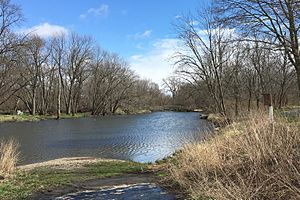
This place is called as the "Crown Jewel" of Naperville. It is considered a place of beauty and tranquility on the side of Dupage River. It features 1.75 miles of brick paths, fountains, bridges, meeting and event places, outdoor sculpture and artwork, recreational facilities, and celebratory memorials. The Naperville Riverwalk was created in 1981 as a permanent commemorative to honor Naperville’s 150th anniversary.The Naperville Riverwalk was created in 1981 as a permanent commemorative to honor Naperville’s 150th anniversary.The Riverwalk has amenities along its path. To the east, visitors enjoy Fredenhagen Park with its landmark clock tower and Exchange Club Memories Fountain. Midway, the Dandelion Fountain, Paddleboat Quarry and unique bell tower can be found. Further west is historic Centennial Beach with its 6.2 million gallons of water that starts with zero depth and goes as deep as 15 feet. It is classified as a “beach” through the Illinois Department of Health and not as a swimming pool. The water itself is chlorinated, re-circulated and hand-skimmed to remove debris, but it is not filtered like a typical swimming pool. Further west is Centennial Park with its inline skating/skateboarding facility and the Jaycee Playground.
Sister cities
 |
North Aurora | Warrenville | Wheaton |  |
| Aurora | Lisle | |||
| Plainfield | Bolingbrook | Woodridge |
Economy
Naperville is within the Illinois Technology and Research Corridor. Employers contributing to the population explosion of the 1980s and 1990s included: Bell Labs and Western Electric (once Alcatel-Lucent, now Nokia), Amoco (now BP and Ineos), Nalco, Calamos, Nicor, and Edward Hospital. and ConAgra's Grocery division branch office employs approximately 400 workers. Kraft Foods (now Mondelez International) opened their Naperville site in 1968, and employs over 200 individuals at the plant, which supplies all Triscuit products for North America. Naperville is also home to the headquarters of Dukane Precast, and their double-wall precast concrete manufacturing plant. Naperville was one of the ten fastest growing communities in the United States during the 1990s. Naperville used to be home to the Office Max headquarters, until 2013 when the merger between Office Depot and Office Max occurred. The former Office Max headquarters in Naperville was sold, as the merged company moved to Boca Raton.
The Naperville area is home to many retailers, restaurants and shopping centers, such as Downtown Naperville, Freedom Commons, Springbrook Prairie Pavilion, and the Route 59 and Ogden Avenue corridors. Naperville has over eleven automobile dealerships, and in October 2006, the city opened the country's first public–private partnership automobile test track, situated on a 9-acre (3.6 ha) course, at a cost of $1.5 million.
According to the 2019 American Community Survey, 77% of commuters drove, 11% took public transportation, and 8.6% worked from home. 22.1% of workers were employed in Educational services, and health care and social assistance, 20.4% were employed in professional, scientific, and management, and administrative and waste management services, 10.3% were employed in arts, entertainment, and recreation, and accommodation and food services, 9.7% were employed in retail trade, and 9.5% were employed in finance and insurance, and real estate and rental and leasing.
According to the city's 2020 Comprehensive Annual Financial Report, the city's top ten employers are:
| # | Employer | # of Employees |
|---|---|---|
| 1 | Edward Hospital | 4,500 |
| 2 | Indian Prairie School District 204 | 3,071 |
| 3 | Nokia | 2,750 |
| 4 | Naperville Community Unit School District 203 | 2,300 |
| 5 | BP America | 1,200 |
| 6 | BMO Harris | 1,200 |
| 7 | Nalco | 1,200 |
| 8 | City of Naperville | 933 |
| 9 | North Central College | 700 |
| 10 | Coriant | 600 |
Education
Colleges and universities
Naperville has multiple colleges and universities within its city limits. North Central College is on a 59-acre (24 ha) campus in Downtown Naperville on Chicago Avenue. It was founded by a predecessor to the United Methodist Church in 1861 and has been in Naperville since 1870. The college remains affiliated with the United Methodist Church. In fall 2020, it had 2,832 students enrolled. Northern Illinois University maintains a satellite campus on Diehl Road offering several courses. The College of DuPage, Dupage County's Community College, operates the Naperville Regional Center which offers several classes. DeVry University has their administrative headquarters, and classrooms on Diehl Road in Naperville. Governors State University maintains a satellite campus on West 95th Street in Naperville. Indiana Tech maintains a satellite campus on North Aurora Road.
Primary and secondary schools
Two K-12 public school districts serve the city of Naperville (along with a number of private, parochial schools).
Naperville Community Unit School District 203 serves central and northern Naperville as well as portions of the neighboring Lisle and Bolingbrook. The oldest District 203 building still in use is Ellsworth Elementary, constructed in 1928, while the newest is the Ann Reid Early Childhood Center, opened in 2010.
District 203 has two high schools: Naperville Central High School and Naperville North High School, five junior high schools and fifteen elementary schools within Naperville city limits. Additionally, the school district has one junior high and one elementary school in Lisle.
Indian Prairie School District 204 (IPSD) was also formed through merged districts in 1972. Neuqua Valley High School, along with three middle schools and 19 elementary schools from this district, are located within southern Naperville. In total, IPSD runs four high schools (Neuqua Valley High School, Metea Valley High School, Wheatland Academy and Waubonsie Valley High School), seven junior high schools, 21 elementary schools, and one preschool. The district serves western and southwestern Naperville, along with eastern Aurora and parts of Bolingbrook and Plainfield.
Naperville is home to numerous private schools, including, All Saints Catholic Academy, Bethany Lutheran School, Calvary Christian School, Covenant Classical School, Naperville Christian Academy, St. Raphael School, and Saints Peter and Paul School.
Infrastructure
Transportation
Roads
The Ronald Reagan Memorial Tollway (the tolled portion of Interstate 88) passes through northern Naperville. US Route 34 (Ogden Avenue) enters Naperville in the west at Illinois Route 59. A diverging diamond interchange, the first in Northeast Illinois, was completed in 2015 at the junction of Route 59 and Interstate 88.
Train service
The city's first rail link to Chicago was established in 1864 by the Chicago, Burlington and Quincy Railroad. Naperville currently has three tracks belonging to the BNSF Railway that run through the north end of town, with passenger rail service provided by Metra and Amtrak. Amtrak's four daily trains through Naperville are the Illinois Zephyr and Carl Sandburg (both destined for Quincy, Illinois), the California Zephyr (destined for Emeryville, California), and the Southwest Chief (destined for Los Angeles). A third Metra station was planned on the Suburban Transit Access Route ("STAR") at Wolf's Crossing. The project is no longer active since 2012.
Bus service
Pace provides rush hour bus service to the Metra stations, and previously, through 2008, had provided for local midday service. Both services have always been operated under contract; First Student, a national transportation management firm, is the current contract operator. In addition, Pace directly operates bus route 530 from Naperville to Aurora (which serves Aurora's Fox Valley Mall) and bus route 714 from Naperville to Wheaton (which serves the College of DuPage), both through its Fox Valley division. Pace also directly operates route 888, a rush hour express route named the "Tri-State Flyer", from Homewood and South Holland to corporate employment sites in the western suburbs, including those in the northern part of Naperville; this route is operated by Pace through its South division. Intercity bus service in Naperville consists of a route from Chicago and Naperville to Davenport, Iowa, and points further west, operated by both Burlington Trailways and Greyhound Lines. The Burlington Trailways buses stop at the Naperville Metra and Amtrak station, downtown on Fourth Avenue; the Greyhound Lines buses stop at the Route 59 Metra station.
Airport
The DuPage Airport, a general aviation airport serving private and charter jets, designation DPA, is 14 miles from downtown Naperville. Clow airport in Bolingbrook is about 1.5 miles from the southeastern border of Naperville.
There is also one private airport, the Naper Aero Club field, designation LL10, on the western edge of town. The field is notable for being the home of the Lima Lima Flight Team.
Electricity
Naperville’s electric system is owned and operated by the City of Naperville, which obtains electricity through the Illinois Municipal Electric Agency, a non-profit government entity.
Notable people
Images for kids
-
The Martin-Mitchell Mansion, within the Naper Settlement outdoor museum, is listed on the National Register of Historic Places
See also
 In Spanish: Naperville para niños
In Spanish: Naperville para niños



